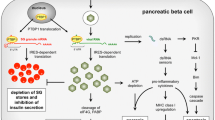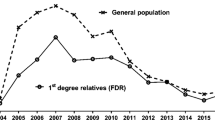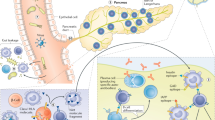Abstract
Type 1 diabetes (T1D) results from an autoimmune destruction of insulin-producing beta cells that requires lifelong insulin treatment. While significant advances have been achieved in treatment, prevention of complications and quality of life in diabetic people, the identification of environmental triggers of the disease is far more complex. The island of Sardinia has the second highest incidence of T1D in the world (45/100,000), right after Finland (64.2/100,000). The genetic background as well as the environment of the island’s inhabitants makes it an ideal region for investigating environmental, immunological and genetic factors related to the etiopathogenesis of T1D. Several epidemiological studies, conducted over the years, have shown that exposures to important known environmental risk factors have changed over time, including nutritional factors, pollution, chemicals, toxins and infectious diseases in early life. These environmental risk factors might be involved in T1D pathogenesis, as they might initiate autoimmunity or accelerate and precipitate an already ongoing beta cell destruction. In terms of environmental factors, Sardinia is also particular in terms of the incidence of infection with Mycobacterium avium paratuberculosis (MAP) that recent studies have linked to T1D in the Sardinian population. Furthermore, the unique geochemical profile of Sardinia, with its particular density of heavy metals, leads to the assumption that exposure of the Sardinian population to heavy metals could also affect T1D incidence. These factors lead us to hypothesize that T1D incidence in Sardinia may be affected by the exposure to multifactorial agents, such as MAP, common viruses and heavy metals.


Similar content being viewed by others
References
Concannon P, Rich SS, Nepom GT (2009) Genetics of type 1A diabetes. N Engl J Med 360:1646–1654
Velluzzi F, Secci G, Sepe V et al (2016) Prediction of type 1 diabetes in Sardinian schoolchildren using islet cell autoantibodies: 10-year follow-up of the Sardinian schoolchildren type 1 diabetes prediction study. Acta Diabetol 53:73–79
Tuomilehto J (2013) The emerging global epidemic of type 1 diabetes. Curr Diabetes Rep 13:795–804
Harjutsalo V, Lammi N, Karvonen M, Groop P-H (2010) Age at Onset of type 1 diabetes in parents and recurrence risk in offspring. Diabetes 59:210–214
Songini M, Lombardo C (2010) The Sardinian way to type 1 diabetes. J Diabetes Sci Technol 4:1248–1255
DIAMOND Project Group (2006) Incidence and trends of childhood type 1 diabetes worldwide 1990–1999. Diabet Med 23:857–866
Bruno G, Maule M, Biggeri A et al (2013) More than 20 years of registration of type 1 diabetes in Sardinian children. Diabetes 62:3542–3546
Harjutsalo V, Sund R, Knip M, Groop PH (2013) Incidence of type 1 diabetes in Finland. JAMA 310:427–428
Atkinson MA, Eisenbarth GS, Michels AW (2013) Type 1 diabetes. Lancet 383:69–82
Contu D, Morelli L, Zavattari P et al (2002) Sex-related bias and exclusion mapping of the nonrecombinant portion of chromosome Y in human type 1 diabetes in the isolated founder population of Sardinia. Diabetes 51:3573–3576
Casu A, Pasciutto C, Bernardinelli L, Songini M (2004) Type 1 diabetes among Sardinian children is increasing: the sardinian diabetes register for children aged 0–14 years (1989–1999). Diabetes Care 27:1623–1629
Gale EAM (2002) The rise of childhood type 1 diabetes in the 20th century. Diabetes 51:3353–3561
Songini M, Loche M, Muntoni S et al (1993) Increasing prevalence of juvenile onset type 1 (insulin-dependent) diabetes mellitus in Sardinia: the military service approach. Diabetologia 36:547–552
Bruno G, Gruden G, Songini M (2016) Incidence of type 1 diabetes in age groups above 15 years: facts, hypothesis and prospects for future epidemiologic research. Acta Diabetol 53:334–339
TEDDY Study Group (2008) The environmental determinants of diabetes in the young (TEDDY) study. Ann NY Acad Sci 1150:1–13
Berhan Y, Waernbaum I, Lind T, Mollsten A, Dahlquist G, Swedish Childhood Diabetes Study Group (2011) Thirty years of prospective nationwide incidence of childhood type 1 diabetes: the accelerating increase by time tends to level off in Sweden. Diabetes 60:577–581
Bach JF, Chatenoud L (2012) The hygiene hypothesis: an explanation for the increased frequency of insulin-dependent diabetes. Cold Spring Harb Perspect Med. doi:10.1101/cshperspect.a007799
Monto AS (1999) Francis field trial of inactivated poliomyelitis vaccine: background and lessons for today. Epidemiol Rev 21:7–23
Viskari H, Ludvigsson J, Uibo R et al (2005) Relationship between the incidence of type 1 diabetes and maternal enterovirus antibodies: time trends and geographical variation. Diabetologia 48:1280–1287
Zinkernagel RM (2003) On natural and artificial vaccinations. Annu Rev Immunol 21:515–546
Oikarinen S, Tauriainen S, Hober D et al (2014) Virus antibody survey in different European populations indicates risk association between coxsackievirus B1 and type 1 diabetes. Diabetes 63:655–662
Fanciulli G, Serra C, Trova G et al (2015) Antibodies against coxsackievirus B4 in Sardinian schoolchildren with positivity to islet cell antibodies. Infect Dis Trop Med 1:e88
Ramondetti F, Sacco S, Comelli M et al (2012) Type 1 diabetes and measles, mumps and rubella childhood infections within the Italian Insulin-dependent Diabetes Registry. Diabet Med 29:761–766
Kondrashova A, Hyöty H (2014) Role of viruses and other microbes in the pathogenesis of type 1 diabetes. Int Rev Immunol 33:284–295
Ojetti V, Migneco A, Silveri NG, Ghirlanda G, Gasbarrini G, Gasbarrini A (2005) The role of H. pylori infection in diabetes. Curr Diabetes Rev 1:343–347
Colombo C, Tomasi PA, Meloni GF, Marinaro AM, Ogana A, Meloni T (2002) Seroprevalence of Helicobacter pylori in children with type 1 diabetes mellitus in Sardinia. Diabetes Nutr Metab 15:91–95
Masala S, Cossu D, Piccinini S et al (2014) Recognition of zinc transporter 8 and MAP3865c homologous epitopes by new-onset type 1 diabetes children from continental Italy. Acta Diabetol 51:577–585
Dow CT (2012) M. paratuberculosis heat shock protein 65 and human diseases: bridging infection and autoimmunity. Autoimmune Dis. doi:10.1155/2012/150824
Sechi LA, Ruehl A, Ahmed N et al (2007) Mycobacterium avium subspecies paratuberculosis infects and multiplies in enteric glial cells. World J Gastroenterol 13:5731–5735
Sechi LA, Rosu V, Pacifico A, Fadda G, Ahmed N, Zanetti S (2008) Humoral immune responses of type 1 diabetes patients to Mycobacterium avium subsp. paratuberculosis lend support to the infectious trigger hypothesis. Clin Vaccine Immunol 15:320–326
Rosu V, Ahmed N, Paccagnini D et al (2009) Specific immunoassays confirm association of Mycobacterium avium subsp. paratuberculosis with type-1 but not type-2 diabetes mellitus. PLoS ONE 4:e4386
D’Amore M, Lisi S, Sisto M, Cucci L, Dow CT (2010) Molecular identification of Mycobacterium avium subspecies paratuberculosis in an Italian patient with Hashimoto’s thyroiditis and Melkersson–Rosenthal syndrome. J Med Microbiol 59:137–139
Sisto M, Cucci L, D’Amore M, Dow TC, Mitolo V, Lisi S (2010) Proposing a relationship between Mycobacterium avium subspecies paratuberculosis infection and Hashimoto’s thyroiditis. Scand J Infect Dis 42:787–790
Cossu D, Cocco E, Paccagnini D et al (2011) Association of Mycobacterium avium subsp. paratuberculosis with multiple sclerosis in Sardinian patients. PLoS ONE 6:e18482
Tognotti E (2009) Program to eradicate malaria in Sardinia, 1946–1950. Emerg Infect Dis 15:1460–1466
Palmas C, Gabriele F, Conchedda M, Bortoletti G, Ecca AR (2003) Causality or coincidence: may the slow disappearance of helminths be responsible for the imbalances in immune control mechanisms? J Helminthol 77:147–153
Knip M, Åkerblom HK, Becker D et al (2014) Hydrolyzed infant formula and early β-cell autoimmunity: a randomized clinical trial. JAMA 311:2279–2287
Patelarou E, Girvalaki C, Brokalaki H, Patelarou A, Androulaki Z, Vardavas C (2012) Current evidence on the associations of breastfeeding, infant formula, and cow’s milk introduction with type 1 diabetes mellitus: a systematic review. Nutr Rev 70:509–519
Nisticò L, Iafusco D, Galderisi A et al (2012) Emerging effects of early environmental factors over genetic background for type 1 diabetes susceptibility: evidence from a nationwide Italian twin study. J Clin Endocrinol Metab 97:E1483–E1491
Mathieu C (2015) Vitamin D and diabetes: where do we stand? Diabetes Res Clin Pract 108:201–209
Di Stasio E, Maggi D, Berardesca E et al (2011) Blue eyes as a risk factor for type 1 diabetes. Diabetes Metab Res Rev. 27:609–613
Cadario F, Savastio S, Pagliardini V et al (2015) Vitamin D levels at birth and risk of type 1 diabetes in childhood: a case–control study. Acta Diabetol 52:1077–1081
Casu A, Carlini M, Contu A, Bottazzo GF, Songini M (2000) Type 1 diabetes in sardinia is not linked to nitrate levels in drinking water. Diabetes Care 23:1043–1044
Andersen ZJ, Raaschou-Nielsen O, Ketzel M et al (2012) Diabetes incidence and long-term exposure to air pollution: a cohort study. Diabetes Care 35:92–98
Mishra KP (2009) Lead exposure and its impact on immune system: a review. Toxicol In Vitro 23:969–972
Khan AR, Awan FR (2014) Metals in the pathogenesis of type 2 diabetes. J Diabetes Metab Disord 13:16. doi:10.1186/2251-6581-13-16
Forte G, Bocca B, Peruzzu A et al (2013) Blood metals concentration in type 1 and type 2 diabetics. Biol Trace Elem Res 156:79–90
Schiraldi M, Monestier M (2009) How can a chemical element elicit complex immunopathology? Lessons from mercury-induced autoimmunity. Trends Immunol 30:502–509
Valera P, Zavattari P, Sanna A et al (2015) Zinc and other metals deficiencies and risk of type 1 diabetes: an ecological study in the high risk Sardinia island. PLoS ONE 10:e0141262
Hemdan NY, Emmrich F, Faber S, Lehmann J, Sack U (2007) Alterations of TH1/TH2 reactivity by heavy metals: possible consequences include induction of autoimmune diseases. Ann NY Acad Sci 1109:129–137
Havarinasab S, Pollard KM, Hultman P (2009) Gold- and silver-induced murine autoimmunity—requirement for cytokines and CD28 in murine heavy metal-induced autoimmunity. Clin Exp Immunol 155:567–576
Bigazzi PE (1994) Autoimmunity and heavy metals. Lupus 3:449–453
Tsai CP, Lee CT (2013) Multiple sclerosis incidence associated with the soil lead and arsenic concentrations in Taiwan. PLoS ONE 8:e65911
Kuo CC, Howard BV, Umans JG et al (2015) Arsenic exposure, arsenic metabolism, and incident diabetes in the strong heart study. Diabetes Care 38:620–627
Thayer KA, Heindel JJ, Bucher JR, Gallo MA (2012) Role of environmental chemicals in diabetes and obesity: a national toxicology program workshop review. Environ Health Perspect 120:779–789
Druwe IL, Vaillancourt RR (2010) Influence of arsenate and arsenite on signal transduction pathways: an update. Arch Toxicol 84:585–596
Díaz-Villaseñor A, Hiriart M, Cebrián ME, Zacarías-Castillo R, Ostrosky-Wegman P (2008) The activity of calpains in lymphocytes is glucose-dependent and is decreased in diabetic patients. Blood Cells Mol Dis 40:414–419
Tseng CH (2004) The potential biological mechanisms of arsenic-induced diabetes mellitus. Toxicol Appl Pharmacol 197:67–83
Valera P, Zavattari P, Albanese S et al (2013) A correlation study between multiple sclerosis and type 1 diabetes incidences and geochemical data in Europe. Environ Geochem Health 36:79–98
Samuelsson U, Oikarinen S, Hyöty H, Ludvigsson J (2011) Low zinc in drinking water is associated with the risk of type 1 diabetes in children. Pediatr Diabetes 2:156–164
Jansen J, Rosenkranz E, Overbeck S et al (2012) Disturbed zinc homeostasis in diabetic patients by in vitro and in vivo analysis of insulinomimetic activity of zinc. J Nutr Biochem 23:1458–1466
Jansen J, Karges W, Rink L (2009) Zinc and diabetes—clinical links and molecular mechanisms. J Nutr Biochem 20:399–417
Ho E, Quan N, Tsai YH, Lai W, Bray TM (2001) Dietary zinc supplementation inhibits NFkappaB activation and protects against chemically induced diabetes in CD1 mice. Exp Biol Med (Maywood) 26:103–111
Kelleher SL, McCormick NH, Velasquez V, Lopez V (2011) Zinc in specialized secretory tissues: roles in the pancreas, prostate, and mammary gland. Adv Nutr 2:101–111
Bosco MD, Mohanasundaram DM, Drogemuller CJ, Lang CJ, Zalewski PD, Coates PT (2010) Zinc and zinc transporter regulation in pancreatic islets and the potential role of zinc in islet transplantation. Rev Diabet Stud 7:263–274
Virtanen SM (2016) Dietary factors in the development of type 1 diabetes. Pediatr Diabetes 17(Suppl 22):49–55
Rewers M, Ludvigsson J (2016) Environmental risk factors for type 1 diabetes. Lancet 387:2340–2348
Author information
Authors and Affiliations
Corresponding author
Ethics declarations
Conflict of interest
The authors declare that they have no conflict of interest.
Human and animal rights
This article does not contain any studies with human or animal subjects performed by the any of the authors.
Informed consent
For this type of study formal consent is not required.
Additional information
Managed by Massimo Federici.
Rights and permissions
About this article
Cite this article
Songini, M., Mannu, C., Targhetta, C. et al. Type 1 diabetes in Sardinia: facts and hypotheses in the context of worldwide epidemiological data. Acta Diabetol 54, 9–17 (2017). https://doi.org/10.1007/s00592-016-0909-2
Received:
Accepted:
Published:
Issue Date:
DOI: https://doi.org/10.1007/s00592-016-0909-2




